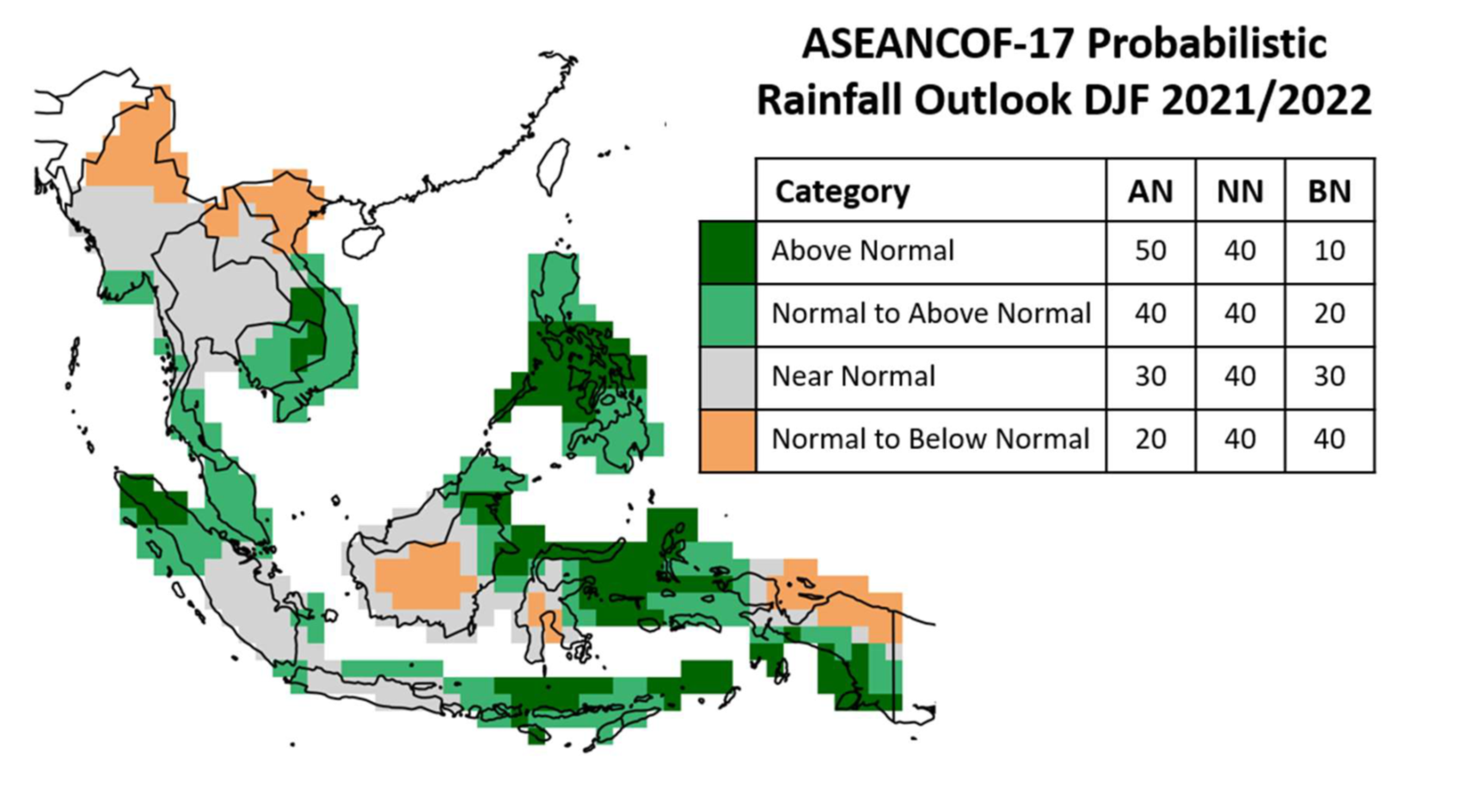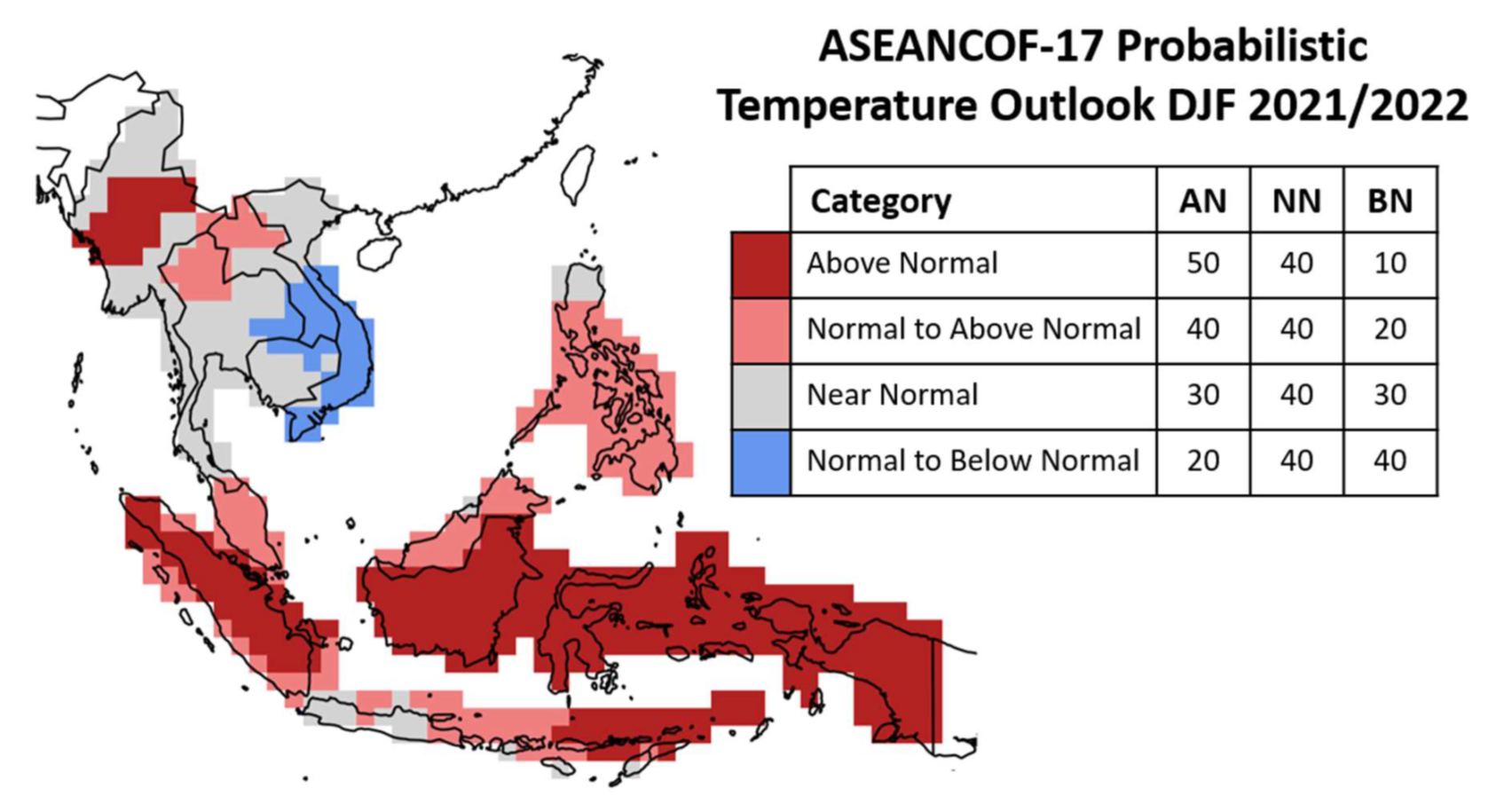01 DEC 2021
ASEAN Climate Outlook Forum
Seventeenth Session of the ASEAN Climate Outlook Forum (ASEANCOF-17)

22, 23, 24, 26 November 2021, ASEAN Specialised Meteorological Centre
Consensus Bulletin for December-January-February (DJF) 2021/2022 Season
The ASEAN Climate Outlook Forum (ASEANCOF) is an avenue to collaboratively develop consensus-based seasonal climate outlooks and related information on a regional scale. The forum’s outlook and its activities contribute significantly to one of the key roles of the ASEAN Specialised Meteorological Centre (ASMC), which is to conduct climate and seasonal prediction for the ASEAN region through pooling the expertise of ASEAN National Meteorological and Hydrological Services (NMHSs). In 2021, the ASEANCOF Working Group was established with the goal to guide and support the long-term development of ASEANCOF, in particular with regard to the implementation of objective outlooks.
The seventeenth session of ASEANCOF (ASEANCOF-17) was organised by the ASEAN Specialised Meteorological Centre (ASMC) in conjunction with the ASEANCOF Working Group. Representatives from the NMHSs of ASEAN Member States created a consensus forecast for the boreal winter monsoon 2021/2022 in the ASEAN region. The consensus for December-January-February (DJF) 2021/2022 outlooks was achieved through an online session, which included presentations from NMHSs and Global Producing Centres (GPCs) of seasonal outlooks, questionnaires and discussions regarding the current conditions and predictions for the Southeast Asia region. In particular, the forum considered the possible influence of the El Niño Southern Oscillation (ENSO) and the Indian Ocean Dipole (IOD) on the climate system over Southeast Asia.

Conditions and Outlook
Recent analyses of sea surface temperature (SST) anomalies over the equatorial Pacific indicated below-average SSTs across most of the central and eastern tropical Pacific Ocean. Most ENSO indicators are now in line with La Niña conditions. The international climate outlooks predict that La Niña conditions are likely to prevail during DJF 2021/2022. The La Niña conditions are expected to be weak to moderate during this time. Conditions are predicted to weaken in boreal spring 2022.
The current Indian Ocean Dipole (IOD) state is neutral and is expected to remain neutral for DJF 2021/2022.
The onset of the Northeast Monsoon season is expected to be or has been near-normal for much of the region, although the onset was earlier than normal for Viet Nam. Over much of Southeast Asia, the strength of the Northeast monsoon is expected to be near normal or stronger than normal, based on model predictions and supported by the current La Niña conditions.
Overall, the tropical cyclone frequency is expected to be above-average for the Bay of Bengal, while near-average around the West Philippine Sea/South China Sea and the Western North Pacific (WNP). This is based on model predictions. During La Niña events, there tends to be more tropical cyclones than average, however, the late onset of the La Niña event as well as its predicted strength means that the increase is not expected to be significant in DJF 2021/2022 for much of the region.
Taking into consideration the national level forecasts, the present state of the climate, and the forecasts available from the GPCs and other global centres, the forum agreed on the following consensus-based outlook for DJF 2021/2022 for the Southeast Asia region:
RAINFALL
Over much of the Maritime Continent, near- to above-normal rainfall is expected. In particular, above-normal rainfall is predicted for central parts of the Philippines, while near- to above-normal rainfall is predicted over Malaysia, Singapore, and Brunei Darussalam.
Over Mainland Southeast Asia, a mix of below- to above- normal rainfall is predicted. Below- to near- normal rainfall is predicted over northern Myanmar, northern Lao PDR, and northern Viet Nam. Above-normal rainfall is predicted over southern Lao PDR, while near- to above-normal rainfall is predicted over parts of southern Myanmar, southern Thailand, parts of Cambodia, and southern Viet Nam. Elsewhere in Mainland Southeast Asia rainfall is predicted to be near-normal1.
1 This is based on the climatology period 1991-2020. Note that some ASEAN countries are expected move to the new rainfall climatology period in 2022.
TEMPERATURE
Over much of the Maritime Continent, near- to above-normal temperature is predicted. Near-normal temperature is predicted for Brunei Darussalam and northern Philippines, with near- to above-normal and above-normal temperature predicted elsewhere.
For Mainland Southeast Asia, a mix of below- to above-normal temperatures are predicted. The highest likelihood of below-normal temperature is over southern Lao PDR and southern Viet Nam. The highest likelihood of above-normal temperature is over central Myanmar, followed by northern Thailand and northern Lao PDR2.
2 This is based on the climatology period 1991-2020. Note that some ASEAN countries, including the Philippines are expected move to the new temperature climatology period in 2022.
Refer to Annex A for reference on what is meant by “above, near, or below normal” in the outlook. For more information on the boreal (Northern Hemisphere) winter monsoon outlook and further updates on the national scale, the relevant NMHSs should be consulted (see Annex B).
Consensus Maps for DJF 2021/2022 Season
The following maps provide the probabilistic outlooks for DJF 2021/2022 season in terms of tercile categories of “Above Normal” (AN: upper tercile), “Near Normal (NN: middle tercile) and “Below Normal” (BN: lower tercile).
PROBABILISTIC RAINFALL OUTLOOK

PROBABILISTIC TEMPERATURE OUTLOOK

Acknowledgements
The Forum would like to convey its appreciation to the National Meteorological Services of the ASEAN Member States for sharing their national-level forecasts, the Global Producing Centres, the Southeast Asia Regional Climate Centre – Network, and other partners of ASEANCOF for sharing their products and expertise, and WMO for their continued support of ASEANCOF.
Back